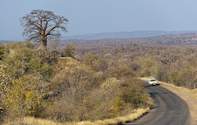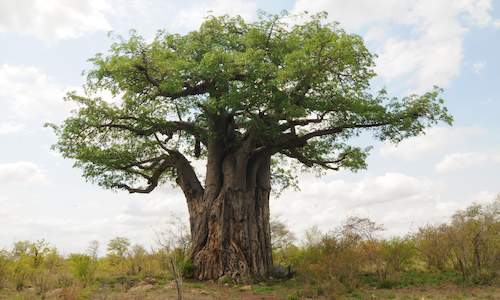
The Mighty Baobab
An icon of the lowveld, the baobab tree is probably one of the most charismatic representatives of the plant kingdom. Popular with humans and animals alike, the tree's bounty makes it a "keystone species" in the Kruger National Park (KNP), with many species of mammals, birds and reptiles relying on it for food and shelter. It is also South Africa's "Tree of the Year' for 2005. Some time ago scientists in the park began to worry about whether elephants were threatening the baobab population in the park.The Trees Elephants Like
The latest researcher to investigate the relationship between trees and elephants in Kruger is Michele Hofmeyr. She has spent many days in the field looking for baobabs and marula, another keystone species thought to be vulnerable to elephants. Two other species were also investigated. Sterculia rogersii, the common star chestnut is a relatively rare species that elephants also find tasty.The false marula, Lannea schweinfurthii is also considered to be vulnerable to elephant activity. All the trees found, alive or dead, were measured and checked for elephant damage, using a scale developed in previous studies. In her survey, Michele located and measured over 1,000 baobab trees, but found only 25 star chestnuts, which occur in the same terrain that baobabs prefer. She did not find any baobab seedlings growing in the veld, with most of the plants having a girth of well over a metre.
Is Infertility the Issue?
Finding no baby baobabs immediately raised further questions, and Michele began to wonder if something had caused the trees to produce infertile seeds. Taking seed pods collected from throughout the park, she sowed the seeds at the Skukuza nursery. Under the ideal conditions provided there, the seeds began to germinate within days, growing up to a metre high in the first year.Over the next few months hundreds of seeds had germinated, and today, a few years on, every time the soil is turned in the seedbeds, new baobabs poke up. With seed infertility ruled out, further scrutiny of the measured baobabs showed that the trees show large numbers of trees of certain sizes, separated by lower numbers of trees whose sizes fall in between the peak sizes. This tends to show what is known as "episodic recruitment" where seeds need certain conditions to germinate and grow into an adult plant.
Rainfall, Fires and Herbivores
Poor rainfall, frequent fires and high numbers of herbivores that continually eat away the leaves that small plants produce could all prevent trees reaching a size where they could withstand adverse conditions. A previous researcher related an episode of baobab recruitment to an anthrax outbreak, with decreased numbers of herbivores available to munch on tender saplings. Looking at elephant damage to the baobabs, almost 30 percent of the trees showed moderate damage. Only a very small proportion of the trees showed severe damage.Fires are responsible for the damage of large trees as they damage tree tissues and remove the lower crown biomass. Elephants play an equally destructive role in the existence of large trees by breaking their branches, debarking them, and sometimes even pushing them over.
The Mightier Elephant
A higher percentage of damaged trees were found in flat, open areas close to water and next to elephant paths. Baobabs growing on rocky hillsides tended to be less utilised by elephants and also showed a greater variety in the sizes of plants growing there. Mostly bigger trees, which can survive more elephant damage, were found in the flatter areas. Some of these trees have been stunted by elephant usage and may not be able to produce viable seeds, but the populations on hills could counteract this effect.The low numbers of star chestnuts means that this species is potentially more at risk from elephants, and Michele believes that further work is necessary to learn more about the tree. Studying the marulas and false marulas, false marulas appeared to be more frequently damaged by elephants than marula trees. There were fewer false marulas than marula found in the study. Many trees of both species had not been damaged at all by elephants in the past, and no dead trees appeared to have been killed through elephant utilisation.
An interesting phenomenon was seen in the 300ha of roan enclosure, where roan antelope have been fenced in without elephants and other browsers since 1967. Here, marula trees of the size 40-80cm were common. This size of tree was much rarer outside the enclosure. Both marulas and false marulas seem to have been affected by the way in which burning has been carried out in the park in the past.
Many small trees seem to be 'trapped' in the grass layer at a small size, showing coppice growth forms, where many small branches shoot out of a single stem after some kind of damage to the plant. Some plants showed signs of having been repeatedly burnt. Michele says, "Trees work on a timescale of hundreds and thousands of years. What we see now is a window into the past." Research is ongoing into the factors that shape tree populations in the park, considering not only the influence of herbivores like elephants, giraffe, kudu and impala, but also the non-living forces, such as fire and rainfall.
Is Culling the Answer?
Defined as the selective killing of animals to ensure population control, culling might seem to be the perfect solution to the unmanageable populations of elephant in the Kruger National Park. The question that is posed, however, is whether or not purposely killing animals would have an effect on the habitat in the future.Elephants are admired for their magnificent memory, hence the concern of culling. Previous studies have highlighted the negative effects that culling has had on elephant populations when previously calm elephants started killing large numbers of rhino, unusual for these herbivorous mammals. The study done in the late 1990s had picked up a form of post-traumatic stress disorder in the animals, which led to increasingly aggressive behaviour.
Elephant populations are led by a matriarch, and the social behaviour of these naturally humble creatures collapses into a state of aggression when the females are culled and the youth have nowhere to learn their social behavioural skills from.
By Melissa Wray

 African trees guide to tree species in the Kruger National Park and South Africa. This Africa Tree Guide includes descriptive information, i...
African trees guide to tree species in the Kruger National Park and South Africa. This Africa Tree Guide includes descriptive information, i...